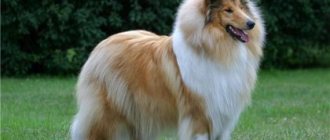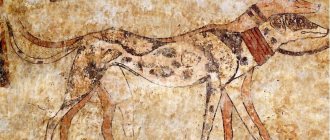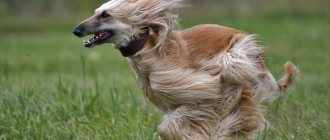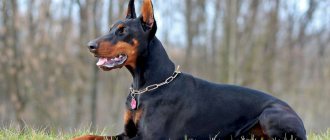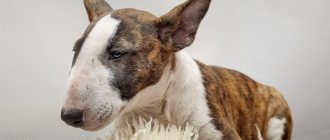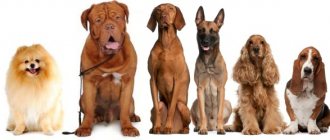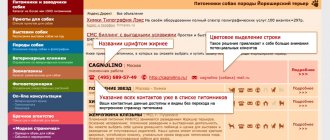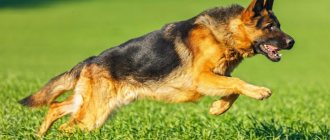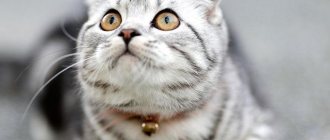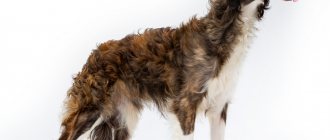This is a born hunter. She can pursue her prey for a very long time without giving a signal to her owner. When the chase takes them into rough terrain, Deerhound increases his speed, knocking the deer down and immobilizing it. Only after this does he give a sign. People come and take the loot.
Characteristics and breed standard
The Scottish Greyhound or Deerhound is a large, muscular, slender dog with a build similar to a Greyhound.
Height at withers: males minimum 76 cm, females minimum 71 cm Weight: 36.5-45.5 kg
Color: bluish-gray, fawn, sandy-red, shades of gray and brindle. White markings on the toes, chest, and tip of the tail are acceptable.
- The hair on the body is bristly, long (hair length is up to 10 cm). On the chest and belly the fur is softer; on the muzzle it creates a mustache and beard.
- Square or elongated body. The legs are long and straight.
- The head is elongated, but proportional to the body, with straight lines, with a smooth transition from the forehead to the muzzle, and strong jaws.
- Acceptable eye color is dark brown.
- The ears are small, hanging on cartilage, and set high. When the dog is calm, he pulls them back or presses them to his head.
- The color of the nose is black, and in fawn-blue dogs it is blue.
- The long tail is lowered when at rest, sometimes curved. When moving, the dog raises it, but not higher than the level of the back.
Description
The coat is mostly grey. There is an admixture of light or even completely white hair. On the face it is very hard, but closer to the back and belly it becomes soft and silky.
Weight is about 35-36 kg for girls and 44-45 for boys. Height from 70 and from 75 respectively.
This is a very athletic dog. Loves running and chasing. When hunting during a chase, it can reach speeds of up to 50 km/h. In the forest it is much smaller, since the dog is not agile and has a high risk of crashing into one of the trees. He always shows very high results in competitions and tournaments.
The average lifespan of a dog is about 10-12 years, but with proper care, a healthy diet and exercise, it can live for a year or more.
History of the breed
The first mention of these dogs in the chronicles of Scotland dates back to the 16th century; they were the favorite breed of the nobility. Although dogs similar in appearance lived before with the Picts, the oldest people of Scotland. Proof of this is the discovered ceramic items painted with images of hunting scenes with deerhounds or dogs similar to them.
There is an opinion that the Deerhound and the Irish Wolfhound are relatives, but whether this information is reliable is unknown.
They were bred for deer hunting and were valued for their intelligence, speed, and courage. A dog could single-handedly chase and kill a deer. The breed eventually spread throughout Great Britain and was in demand. Gradually, the number of deer in the forests decreased, and the deerhounds were replaced by greyhounds, hunters of hares.
In the middle of the 18th century, the breed was on the verge of extinction. In the 19th century, thanks to Archibald and Duncan MacNeil, deerhounds appeared at exhibitions and spread beyond Great Britain. In 1889, the Breed Club was created, and in 1892 the first exterior standard appeared. In the same year, the breed was officially recognized.
In the United States, where deer hunting was prohibited, deerhounds were used to bait coyotes. With the advent of firearms, dogs completely faded into the background, and the breed survived only thanks to rare enthusiasts and lovers of hunting with greyhounds.
Today the breed is widespread in England, where the aristocratic Reindeer Greyhound is still the dog of the nobility.
Border Collie
Border collies were bred in the border areas of Scotland and England, so they are only half a Scottish dog breed. The word border is translated as border. The first known border collie was a dog named Ol' Hemp.
From the age of one he participated in sports competitions. He became famous for his outstanding work qualities and unquestioning obedience. During his life, from 1893 to 1901, he became the father of 200 puppies, to whom he passed on his best qualities.
Among Border Collies there are long-haired and short-haired dogs. There are no restrictions on colors; the most common ones are:
- Classic - a combination of black and white.
- Chocolate with white markings.
- Tan - all shades from cream to deep red.
- Lilac or Isabella
- Marble - a pattern of spots of different sizes of the same color.
- Tricolor.
Border collies are emotional, good-natured dogs. They quickly get used to the lifestyle of their owner and family. They sincerely love children and are ready to take care of children for days. Border collies remember words and understand human speech. They take an honorable first place in the list of the most trainable dogs.
Character and temperament
The Deerhound is a gentle and loyal, calm and dignified dog. He is noble and will not show aggression towards humans, although he is distrustful of strangers.
It is interesting that the reindeer hound manages to combine “duality” in itself: at home there is peace itself, but in the forest or on the street a hunting passion immediately awakens in it.
Pros:
- smart;
- loyal;
- calm;
- passionate hunter;
- not aggressive;
- patient;
- does not bark for any reason;
- loves children.
Minuses:
- does not protect;
- doesn't like to be alone;
- active;
- has a strong hunting instinct.
Reviews
Alexey: “I was looking for a dog for hunting. I already had several, so I knew what I was looking for. The purchase was problematic, but all the effort was worth it. This is an amazing, kind dog. Gets along great with the whole extended family.”
Oksana: “I have had many dogs throughout my life. The Deerhound is something unique. I have never seen a dog being thrown so violently from one extreme to another. At home he is alone, on the street he is different, kind to his family, callous to strangers. An incredible dog, you rarely see such love for an owner.”
Scottish Deerhound and man
Today it is more of a companion dog than a hunter, despite the hunting instincts that have not been lost. This is a pet that adores its owner’s family, sensitively capturing everyone’s mood. He does not need a lot of space; the Deerhound feels good in the city, provided it is given good walking. In the apartment he is calm and not prone to destruction. The dog loves comfort, so you need to make sure that he does not encroach on chairs and sofas. But he will be glad to have a soft bed where he can spend the whole day, blissfully and luxuriating.
The Deerhound is patient and loves children. He greets guests with dignity and may wag his tail a couple of times. This dog is not suitable as a guard.
The breed gets along with dogs and other pets.
Where can I buy
There are very few dogs of this breed in Russia, and there is no official breeders club. Therefore, lovers of unusual pets have to travel to Europe, where the price for one puppy is 30,000-70,000 in rubles. It will be available in the following nurseries: Dutch Pitlochry`s, Finnish Black Jades, German Olemule, etc.
An intelligent, good-natured deerhound will not leave indifferent both experienced dog lovers and novice breeders. He will be an excellent option for an active family in need of a loyal pet and friend.
Maintenance and care
The Scottish Greyhound does not require much space, so it is convenient to keep it in a city apartment . Although in a private house with a local area.
The dog can live in a spacious enclosure or in a kennel, but if severe frosts strike, it is better to let the deerhound into the house. It is impossible to keep such a freedom-loving creature on a leash. In hot weather, the deerhound should be able to hide from the scorching sun under a canopy, since it is difficult for him in the sun .
Walks should be long, with active games and interesting activities. The greyhound is walked at least 2 times a day , one of the walks should last at least an hour. It is good if during this walk the dog can run freely or exercise with the owner, accompanying the owner during cycling or jogging.
An adult deerhound is fed 2 times a day in small portions. Prone to gaining excess weight, so pay close attention to how much food your dog eats.
He is not picky about food, but respects fresh lean meat and porridge.
The diet should be balanced: include sea fish, cereals, vegetables and fruits, and dairy products. The dog will not refuse premium dry food.
The Deerhound sheds a lot , so it is not recommended to let him lie on the bed or sofa. Brush your dog's coat daily to remove dead hair and prevent tangling and matting. Trimming is required periodically around the face and ears. Ears are cleaned as they become dirty, claws are trimmed if they do not grind down on the asphalt and ground.
Nutrition
You can feed him commercial food and canned food, but it’s better if you cook for him yourself. In this case, more than half of his diet should be meat. This is a very athletic breed and needs protein to stay in shape. The rest should be vegetables and cereals. Don't forget about dairy products. They are essential for maintaining a healthy metabolism.
Avoid overeating. With a calorie surplus, the dog may begin to gain weight, and this greatly affects the dog’s health.
Education and training
Even beginners have no problems with training, because this is an intelligent and understanding dog. The deerhound remembers commands quickly , but does not like being forced to repeat the same thing over and over again. So be patient and create fun things for your dog while training.
The reindeer greyhound is trained in coursing, running, bikejoring, and is taught to ride a bike or ride a horse.
Sometimes on walks, due to the hunting instinct, a deerhound runs away and begins to chase a cat, squirrel, or bird. This behavior must be stopped from puppyhood.
Dog market
The price of a Deerhound ranges from 30-70 thousand rubles. Depends on the constitution and the availability of a pedigree history document.
But Deerhound puppies of this type of dog are very difficult to find in the Russian Federation. There is no official registration of dog breeders yet. There are some fanciers, but under what conditions the puppies are sold, you will only find out when you meet them in person.
A private deerhound kennel is also rare in Russia, but it does exist if you search the Internet.
Health and life expectancy
Representatives of the breed are not long-lived, living on average 10 years .
Deerhounds are prone to the following diseases:
- portosystemic shunt (pathology of the blood vessels of the liver);
- hypothyroidism (pathology of the thyroid gland);
- stomach torsion;
- respiratory allergies;
- cardiomyopathy (heart pathology);
- cystinuria (hereditary kidney disease).
External signs
The general build of the Deerhound is similar to that of the Greyhound, only larger in size. The chest is deep, not too narrow, which indicates the dog has good lung capacity. The dog's neck is of medium length, strong to hold a deer. The head is wide, tapering towards the nose. The skull is flat, the forehead is slightly convex.
The ears are set high, folded back, soft to the touch. The eyes are medium sized, dark, dark brown, brown.
The forelegs are straight and dry. The hind limbs are widely spaced, which indicates their sufficient strength.
The coat is hard and rough on the body, limbs and neck. It is much softer on the chest and head. The ideal coat is tight-fitting, thick, and hard to the touch.
The color can be any. But bluish-gray is preferred. Sandy red and orange-brown are also highly prized.
Breed photo
A selection of photos of the Scottish Reindeer Greyhound.
Add a comment Cancel reply
Care
Dogs of this breed have a hard time adapting to apartment life. Dogs are more comfortable in nature, where they can run around to their heart's content. They don't like hot weather. Proper care for a Deerhound is no different from basic care for dogs of other breeds.
- The dog's coat requires regular weekly brushing, and trimming is required around the ears and muzzle.
- It is recommended to periodically brush your teeth, eyes, ears, and trim your nails.
- The key to a dog’s health will be quality food, physical activity, space, and communication with other dogs and the owner.
It is better to have greyhounds in your own home. If your dog walks outside a lot, it is important to ensure there is a shaded area. The Deerhound has a negative attitude towards heat. When choosing a dog in an apartment, keep in mind that you will need to provide the dog with daily exercise in the fresh air.
Deerhound puppies are active, prefer to spend most of their time on the move, and love to frolic in nature. However, with age, Deerhound dogs sometimes become lazy; it is important not to forget to take them for a run and let them run without a leash. You should carefully choose a place for such walks: an area surrounded by a fence or a field away from the road.
FAQ:
- combination with children - the pet loves babies, but large sizes can pose a threat. The dog can get too playful and accidentally harm a child; also, at a young age, the breed is characterized by excessive activity and playfulness;
- type of owner – deerhounds are intended for caring owners who try not to leave their pet unattended. You will also need to sacrifice personal time for long walks;
- proximity to other animals - gets along well with other dogs, especially if they are hunting breeds. The peace-loving dog also gets along well with cats. But pets from neighboring houses can awaken hunting instincts in a dog;
- What you should be wary of is that the breed needs socialization lessons, otherwise you risk raising a timid pet.
Feeding
The Deerhound is not picky about food. If the diet is balanced, the dog will not get sick. It is advisable to frequently include raw meat in your diet. He will eat porridge from cereals and meat perfectly. It is advisable to feed the dog twice a day - morning and evening. The breed shows enormous size, eats little, and overfeeding is not recommended. Always leave fresh water available.
The Deerhound will not be offended by its owner when fed once a day. This is normal for adults. The main thing is that the diet is well balanced. The pet must receive the required amounts of minerals and vitamins.
According to veterinarians, ready-made food is considered fully balanced and is purchased in specialized stores or supermarkets. This food has the necessary nutritional properties and provides complete nutrition.
If you become the owner of a small pet, find out what to feed Deerhound puppies. The approximate diet of a puppy up to two months old includes:
- 200-250 g of beef, including 50 g of raw minced meat;
- 200-250 g of cereal (preferably millet, wheat groats or oatmeal);
- 80-100 g of vegetables (preferably carrots and cabbage);
- 25-40 g of greens (dill, parsley, lettuce, nettle);
- 500-800 g of milk or kefir;
- 4 grams of salt;
- 1-2 grams of calcium gluconate.
To diversify the diet, it is permissible to periodically replace meat with eggs or cottage cheese at the rate of 100 g of meat = 1 egg or 300 g of cottage cheese. It’s good that if a small puppy’s diet contains chicken meat, only avoid long bones; ingestion is fraught with serious problems with the intestines. It is better to replace bones with cartilage; products are easier to digest by the stomach.
A couple of times a week, instead of meat, give the puppy boiled fish, after removing the sharp fins. The basis of a small pet's diet will be porridge. Their presence in the diet will guarantee that a grown dog’s metabolic processes are going through correctly. A dog accustomed to porridge from childhood is unpretentious to food in adulthood. Vegetables and herbs are added to the cooked porridge. If your puppy eats boiled vegetables better, that’s okay.
Milk in a puppy’s diet is considered a separate dish, either in its pure form or in the form of milk soups.
Deerhound puppies under the age of one year need vitamins A and D; in the spring, provide children's multivitamins, such as Revit or Oligovit.
Exterior standards:
- general appearance - a large animal, height up to 73 cm, weight up to 45 kg, elongated body, has developed muscles, miniature head, long and slender legs, hard and long hair;
- head – flat skull, elongated muzzle, softer fur than on other parts of the body, strong jaws, muzzle gradually tapers towards the nose;
- eyes are oval in shape, the inner eyelid is black;
- ears – small in size, set high, laid behind the head at rest;
- body – elongated square shape, neck without dewlap, deep chest, protruding loin, powerful croup;
- paws – strong and muscular, limbs compact;
- tail – becomes thinner towards the end, keeps curved in dynamics, and is covered with coarse hair;
- hair – shaggy hair, coarse structure, close-fitting, hair length up to 10 cm, hanging from the body, softer hair on the chest, belly and head;
- color – gray, gray with a blue tint, sand.
